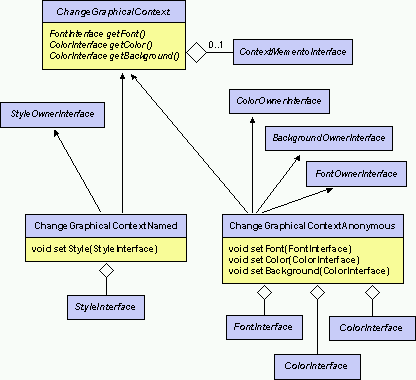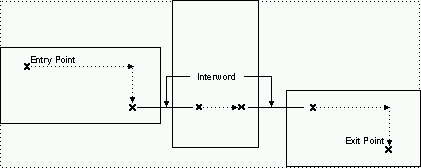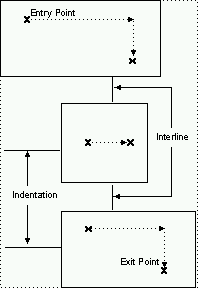|
|
|
|
|
|
|
 Design Design |
 Boxes Boxes |
 Combinator Combinator |
 Formatting Formatting |
 Geometry Geometry |
 Reuse Reuse |
 Selections Selections |
 Paths Paths |
 Concurrency Concurrency |
 Exception Exception |
 Interaction Interaction |
 Utility Utility |
 Resource Resource |
 Drawing Drawing |
 Incremental Incremental |
 Customize Customize |
 Various Various |
Combinators
The API cross references![]() give an immediate access to relevant interfaces and classes.
give an immediate access to relevant interfaces and classes.
 Root Glyph
Root Glyph
The root glyph is specific in that it holds a reference to the facade.
 Change Graphical Context
Change Graphical Context
The attributes attached to a change graphical context are inherited by all subsequent children. Resources specification with a style is preferable to the use of an anonymous way with explicit font and color. When drawing the previous graphical context is saved in a context memento.

 Horizontal
Horizontal
An horizontal arranges its children in horizontal mode. The space between consecutive element is given by the interword. The alignement is made between the exit point and the entry point of two consecutive elements. The only formatting action it knows on its own is reducing the interword.
Here are some implementation issues relative to
optimization![]() of such basic combinator.
of such basic combinator.

 Vertical
Vertical
A vertical arranges its children in vertical mode. The space between consecutive lines is given by the interline. The indentation is a withdrawal applied to each element except the first. The only formatting action it knows on its own is reducing the indentation.
Here are some implementation issues relative to
optimization![]() of such basic combinator.
of such basic combinator.

 Paragraph
Paragraph
A paragraph puts its elements in horizontal mode while
there is enough room till the right margin. Next it
switchs to a new line and so on. So it can be view as a
vertical![]() whose each element is an
horizontal
whose each element is an
horizontal![]() .
In fact, we use for the implementation Line and Column
which are some kind of horizontal and vertical.
Their behaviour only differ when formatting as an
overflow will trigger a
new line action.
.
In fact, we use for the implementation Line and Column
which are some kind of horizontal and vertical.
Their behaviour only differ when formatting as an
overflow will trigger a
new line action.
 Lighweight
Component Adapter
Lighweight
Component Adapter
A lightweight component adapter holds a reference to a java lightweight component. Its allows glyphs and java lightweight components to be mixed.
 Decorations
Decorations
A decorated glyph holds a reference to its component. Its default behavior is to delegate all operations. Its main purpose is adding reponsibilities, as subclasses are free to add specific operations.
 API Cross References
API Cross References
- Interfaces:
- Classes:
- Exceptions:
 Design Design |
 Boxes Boxes |
 Combinator Combinator |
 Formatting Formatting |
 Geometry Geometry |
 Reuse Reuse |
 Selections Selections |
 Paths Paths |
 Concurrency Concurrency |
 Exception Exception |
 Interaction Interaction |
 Utility Utility |
 Resource Resource |
 Drawing Drawing |
 Incremental Incremental |
 Customize Customize |
 Various Various |
|
Comments or suggestions? Need some help? Copyright ©1998 INRIA Last updated 5 October 1998 by Bruno Conductier |
|